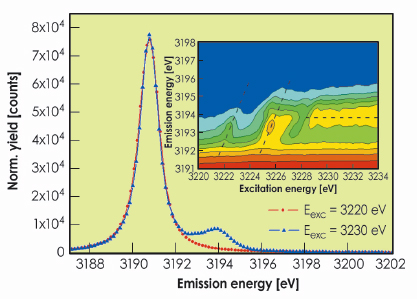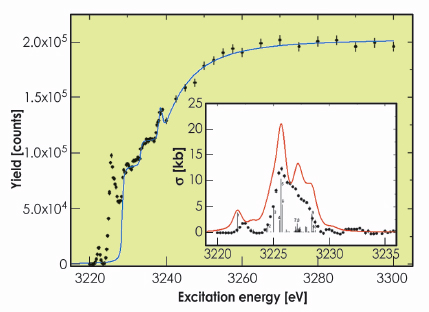- Home
- Users & Science
- Scientific Documentation
- ESRF Highlights
- ESRF Highlights 2009
- Dynamics and extreme conditions
- Two-electron atomic processes induced with a single photon
Two-electron atomic processes induced with a single photon
According to the nature of photon-electron interaction, a single photon can interact directly with only one electron in the atom. A double photoexcitation is therefore necessarily mediated by an electron-electron interaction. Near the double ionisation threshold, three different types of transitions can occur:
- shake-off (double ionisation) where both electrons are ejected out of the atom,
- shake-up transition where ejection of one inner shell electron is accompanied by the simultaneous excitation of another electron into an unoccupied bound atomic state,
- resonant double excitations where both electrons are excited to unoccupied bound states of the neutral atom.
X-ray satellite lines are emitted in the radiative decay of these multielectron states. They are shifted in energy with respect to the diagram line arising from single photoionisation but the spectral contributions of different multielectron processes within the satellite line overlap and cannot be resolved. Resonant inelastic X-ray scattering (RIXS) measurements overcome this limitation; a series of RIXS spectra can be used to effectively separate shake-off, shake-up, and resonant contributions through their characteristic near-threshold behaviour. Since structural solid-state effects would obscure resonant spectral features related to multiple atomic excitations such studies need to be performed on gaseous atomic targets.
A series of RIXS spectra was recorded to analyse the [1s3p] photoexcitation in Ar using the high-resolution Johansson type spectrometer of the J. Stefan Institute at beamline ID26. Figure 16 presents two high resolution KM2,3 X-ray emission spectra recorded at excitation energies slightly below and above the 1s3p threshold. While the first spectrum exhibits only a strong diagram line corresponding to the 1s-3p transition, an additional satellite line appears in the spectrum taken above the threshold, which is attributed to the 1s3p double vacancy state. The inset of Figure 16 presents the RIXS spectral plane for the satellite line in the 1s3p near-threshold region. Along the excitation energy axis of the RIXS plane, two resonant contributions are clearly observed exhibiting a linear Raman-Stokes dispersion. They are followed by a sharp edge typical of the shake-up process. In contrast to the two resonant contributions, no strong dependence on excitation energy is observed above the edge, as expected for excitations into continuum states.
 |
|
Fig. 16: High resolution Ar KM2,3 X-ray emission spectra recorded below and above the double [1s3p] threshold. The inset shows a 2D RIXS map of the KM-M2,3M satellite contribution over the [1s3p] near-threshold region. |
Figure 17 shows the Ar [1s3p] photoexcitation spectrum given as the integral yield of the extracted satellite line versus excitation energy. A simple phenomenological model employing a cumulative distribution together with an exponential saturation functional form for the shake-up and shake off contributions, respectively, and an additional peak to account for the [1s3s] resonant excitation at 3238 eV, accurately reproduces the measured spectrum well above the 1s3p threshold. The signal before the first shake-up edge corresponds to the resonant [1s3p]nln’l’ excitation cross section, and is presented in the inset of Figure 17. The absolute units were obtained by scaling the total measured KM X-ray yield at a given excitation energy with the corresponding absolute photoabsorption cross section of Ar [1]. The experimental spectrum is compared to the model spectrum based on the calculated dipole oscillator strengths of [1s3p]nln’l’ states, taking full account of atomic relaxation. Apart from obtaining good general agreement with experiment, our calculations also reproduce the peak observed at 3222.3 eV excitation energy confirming that it originates from the conjugate process, where the roles of 1s and 3p electrons in the corresponding dipole-monopole excitation are reversed.
 |
|
Fig. 17: Intensity evolution of the KM-M2,3M satellite line as a function of the excitation energy. The solid line represents the fit of the phenomenological model adopted for the region above the double [1s3p] threshold. The inset shows the resonant part of the measured [1s3p] spectrum compared with our calculated spectrum. |
In conclusion, we have measured the Ar resonant 1s3p double photoexcitation spectrum employing high-resolution RIXS spectroscopy on a gas phase target. A detailed comparison with model predictions with respect to energy levels as well as the strength of resonant double excitations was performed. With an effective separation of different two-electron near-threshold contributions, RIXS spectroscopy reaches beyond the standard absorption technique and provides new possibilities to study electron correlation effects in the photoexcitation process.
Reference
[1] M. Deutsch, N. Maskil, and W. Drube, Phys. Rev. A 46, 3963 (1992).
Principal publication and authors
M. Kavčič (a), M. Žitnik (a), K. Bučar (a), A. Mihelič (a), M. Štuhec (a), J. Szlachetko (b,c), W. Cao (b), R. Alonso Mori (d) and P. Glatzel (d), Phys. Rev. Lett. 102, 143001 (2009).
(a) J. Stefan Institute, Ljubljana (Slovenia)
(b) Physics Department, University of Fribourg (Switzerland)
(c) Jan Kochanowski University, Institute of Physics, Kielce (Poland)
(d) ESRF



